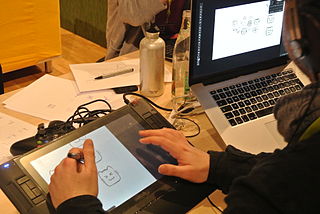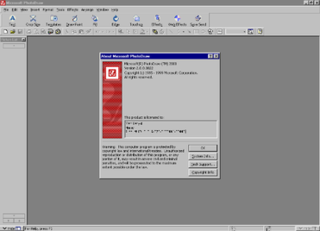
Adobe Photoshop is a raster graphics editor developed and published by Adobe Inc. for Windows and macOS. It was originally created in 1987 by Thomas and John Knoll. Since then, the software has become the most used tool for professional digital art, especially in raster graphics editing. The software's name is often colloquially used as a verb although Adobe discourages such use.

Adobe Illustrator is a vector graphics editor and design program developed and marketed by Adobe Inc. Originally designed for the Apple Macintosh, development of Adobe Illustrator began in 1985. Along with Creative Cloud, Illustrator CC was released. The latest version, Illustrator 2024, was released on October 10, 2023, and is the 28th generation in the product line. Adobe Illustrator was reviewed as the best vector graphics editing program in 2021 by hpMagazine.

Adobe Creative Suite (CS) is a discontinued software suite of graphic design, video editing, and web development applications developed by Adobe Systems.

Adobe Fireworks was a bitmap and vector graphics editor, which Adobe acquired in 2005. Fireworks was made for web designers for rapidly creating website prototypes and application interfaces. Its features included slices, which are segments of an image that are converted to HTML elements, and the ability to add hotspots, which are segments of an image that are converted to hyperlinks. It was designed to integrate with other Adobe products such as Adobe Dreamweaver and Adobe Flash. It was available as either a standalone product or bundled with Adobe Creative Suite. Older versions were bundled with Macromedia Studio. Adobe discontinued Fireworks in 2013, citing the increasing overlap in functionality with its other products such as Adobe Photoshop, Adobe Illustrator, and Adobe Edge.

Digital painting is an art medium created with computer technologies. It employs pixels which are assigned a color to create imagery. It is also known as raster graphics. It is called digital painting because it initially distinguished itself from vector graphics in its ability to render gradiated or blended colors in imagery which mimicked traditional drawing and painting media.

IrfanView is an image viewer, editor, organiser and converter program for Microsoft Windows. It can also play video and audio files, and has some image creation and painting capabilities. IrfanView is free for non-commercial use; commercial use requires paid registration. It is noted for its small size, speed, ease of use, and ability to handle a wide variety of graphic file formats. It was first released in 1996.

Corel Photo-Paint is a raster graphics editor developed and marketed by Corel since 1992. Corel markets the software for Windows and Mac OS operating systems, previously having marketed versions for Linux. Its primary market competitor is Adobe Photoshop.
Thomas Knoll is an American software engineer who created Adobe Photoshop. He initiated the development of image processing routines in 1988. After Knoll created the first core routines, he showed them to his brother, John Knoll, who worked at Industrial Light and Magic. John liked what he saw, suggested new features, and encouraged Tom to bundle them into a package with a graphical user interface. In 1988, John sold the distribution license for Photoshop to Adobe Systems and later on March 31, 1995, he sold the rights to the program to Adobe for $34.5 million.

Adobe ImageReady was a bitmap graphics editor that was shipped with Adobe Photoshop for six years. It was available for Windows, Classic Mac OS and Mac OS X from 1998 to 2007. ImageReady was designed for web development and closely interacted with Photoshop.

Microsoft PhotoDraw was a vector graphics and raster image editing software developed by Microsoft. It was released in 1999 as part of the Microsoft Office 2000 family of products and was specifically designed for creating and editing graphics, illustrations, and photo compositions.

Adobe Captivate is an authoring tool that is used for creating eLearning content such as software demonstrations, software simulations, branched scenarios, and randomized quizzes in HTML5 format.
Raster graphics editors can be compared by many variables, including availability.

Adobe Bridge is a free digital asset management app made by Adobe Inc. and first released with Adobe Creative Suite 2. It is a mandatory component of Adobe Creative Suite, Adobe eLearning Suite, Adobe Technical Communication Suite and Adobe Photoshop CS2 through CS6. Starting with Creative Cloud, however, it has become an optional component downloaded via Creative Cloud subscription.

Adobe Lightroom is a piece of image organization and image processing software developed by Adobe Inc. as part of the Creative Cloud subscription family. It is supported on Windows, macOS, iOS, Android, and tvOS. Its primary uses include importing, saving, viewing, organizing, tagging, editing, and sharing large numbers of digital images. Lightroom's editing functions include white balance, presence, tone, tone curve, HSL, color grading, detail, lens corrections, and calibration manipulation, as well as transformation, spot removal, red eye correction, graduated filters, radial filters, and adjustment brushing. The name of the software is based on darkrooms used for processing light-sensitive photographic materials.
Photoshop plugins are add-on programs aimed at providing additional image effects or performing tasks that are impossible or hard to fulfill using Adobe Photoshop alone. Plugins can be opened from within Photoshop and several other image editing programs and act like mini editors that modify the image.

SilverFast is the name of a family of software for image scanning and processing, including photos, documents and slides, developed by LaserSoft Imaging.
Serif have a range of software products, which are listed below.

Adobe FreeHand is a discontinued computer application for creating two-dimensional vector graphics oriented primarily to professional illustration, desktop publishing and content creation for the Web. FreeHand was similar in scope, intended market, and functionality to Adobe Illustrator, CorelDRAW and Xara Designer Pro. Because of FreeHand's dedicated page layout and text control features, it also compares to Adobe InDesign and QuarkXPress. Professions using FreeHand include graphic design, illustration, cartography, fashion and textile design, product design, architects, scientific research, and multimedia production.

Affinity Photo is a raster graphics editor developed by Serif Ltd. for iOS, macOS, and Windows, alongside Affinity Designer and Affinity Publisher. Development of Affinity Photo started in 2009 as a raster graphics editor for macOS. Its first version reached general availability in 2015 with the Windows version launched a year later. It is a successor to PhotoPlus which Serif discontinued in 2017.









